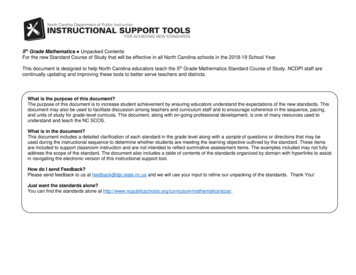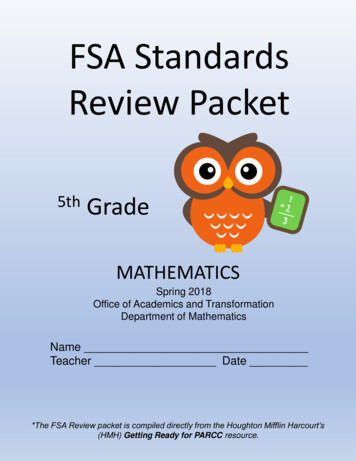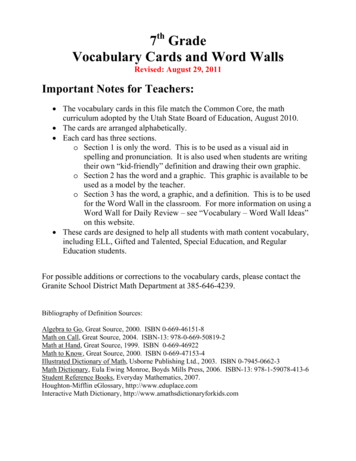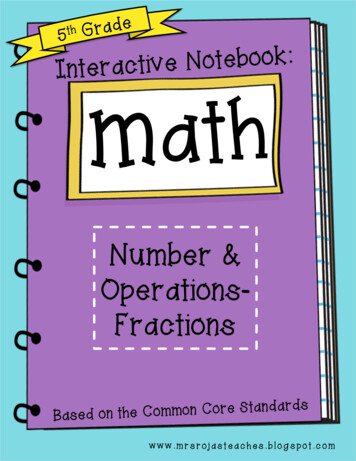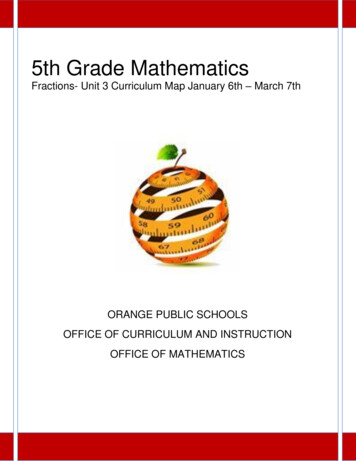
Transcription
5th Grade MathematicsFractions- Unit 3 Curriculum Map January 6th – March 7thORANGE PUBLIC SCHOOLSOFFICE OF CURRICULUM AND INSTRUCTIONOFFICE OF MATHEMATICS
5th Grade Unit 3January 6th – March 7thTable of ContentsI.Unit Overviewp. 3II.Important Dates and Calendarp. 4III.Curriculum Guidep. 5IV.Review Content Overviewp. 6V.Structure of the Modulesp. 8VI.Common Core Standards – Review Contentp. 9 - 28VII.Assessment Check for Review Contentp. 29 - 35VIII.Common Core Standards – Fractionsp. 37IX.Connections to Mathematical Practicesp. 39X.Vocabularyp. 40XI.Potential Misconceptionsp. 43XII.New Content Resourcesp. 44 - 61XIII.Assessment Check 2p. 62 - 79XIV.Extensions and Sourcesp. 801
5th Grade Unit 3January 6th – March 7thCommon Core Grade FluencyREVIEW OF GRADE 4 FLUENCY4.NBT.4Fluently add and subtract multi digit whole numbers using the standard algorithm.EXPECTED 5TH GRADE FLUENCY5.NBT.5Fluently multiply multi-digit whole numbers using standard algorithm.2
5th Grade Unit 3January 6th – March 7thUnit OverviewIn this unit, students will . Use multiple strategies to find equivalent fractionsFind and generate equivalent fractions and use them to solve problemsSimplify fractionsUse concrete, pictorial, and computational models to find common denominatorsUse fractions (proper and improper) and add and subtract fractions and mixed numbers withunlike denominators to solve problemsUse concrete, pictorial, and computational models to multiply fractionsUse concrete, pictorial, and computational models to divide unit fractions by whole number andwhole numbers by unit fractionsEstimate products and quotients3
5th Grade Unit 3 January 6th – March 7thImportant Dates and CalendarWeek of 4MondayTuesdayWednesdayThursdayFridayREVIEW MODULESNo SchoolCheckpoint1/2 DayUNIT 3 NEW CONTENT2/17-2/212/24-2/28NO SCHOOLUNIT 3 NEW CONTENT3/34-3/7Assessment WeekIMPORTANT DATESMonday, Jan 20thFriday, Jan 24thFriday, Jan 31stWeek of Feb 17thFriday, March 14thFriday, March 21stMLK DayCheckpoint 2 Grades 6-71/2 DayVACATIONData DueData Returned to Principals4
5th Grade Unit 3thJanuary 6th – March 7th5 GradeReview ContentActivityTeach NotesModuleReviewCommon CoreStandards/SLO5.NBT.1 - 2Practice ProblemsReview5.NBT.5 – 62 daysPractice ProblemsReview5.NF.32 daysSee above1 daySGO Standards1 dayLessons 1 - 35.NF.1 & 27 daysLesson 4: Golden Problem5.NF.1 & 21 dayLessons 1 - 45.NF.47 daysLesson 5: Golden Problem5.NF.41 day5.NF.55 days5.NF.1, 5.NF.2, 5.NF.4 a,b, 5.NF.5 a,b,2 daysAssessment Check(Review)EstimatedTime5 - 10 daysNew ContentCheckpoint #2(Friday, January 24th)5th Grade Fraction Module5. NF. 1 - 25th Grade FractionModule5. NF. 1 - 25th Grade Fraction Module5. NF. 45th Grade Fraction Module5. NF. 4Various Text ResourcesUnit 3 Assessment5
5th Grade Unit 3January 6th – March 7thReview Content OverviewWeeks One - Three5.NBT. 1 & 2Students will develop a mathematical understanding of place value relating to multi-digit wholeand decimal numbers. Students will be asked to explain patterns in the number of zeroes ofresulting products when multiplying a number by powers of 10, and explain patterns in theplacement of the decimal point when a decimal is multiplied or divided by a power of 10.5.NBT. 5 & 6Students will be able to determine the size of a product based on the factors (relative to 1),and show division of whole numbers with one and two-digit divisors using place value, arrays,area models, and other strategies.5. NF. 3Students will be able to interpret fractions as the division of the numerator by the denominator.6
5th Grade Unit 3January 6th – March 7thReview7
5th Grade Unit 3January 6th – March 7thStructure of the ModulesThe Modules embody 3 integrated frameworks that promote the development of conceptual andproblems solving skills and computational fluency. The conceptual framework of the Modules buildsfrom the concrete to the pictorial to the abstract (and the constant blending of each) to help studentsdevelop a deeper understanding of mathematics. The Modules also reference a multiplerepresentations framework that encourages teachers to present content in multiple modalities tosupport flexible thinking. These frameworks go beyond concrete representation (i.e. manipulatives) topromote the realistic representation of concepts addressed in multiple settings. Lastly, the Modulesembody a „gradual release’ framework that encourages teachers to progress from whole group tocollaborative and finally to an independent practice format.OVERVIEWEach module begins with an overview. The overview provides the standards, goals, prerequisites,mathematical practices, and lesson progression.INTRODUCTORY TASKSThe Introductory Tasks serve as the starting point for the referenced standard and are typically eitherdiagnostic, prerequisite or anticipatory in nature.GUIDED PRACTICEServes for additional teacher guided instruction for students who need the additional help. The taskscan be modeled with students.COLLABORATIVE PRACTICEServe as small group, or partnered work. The work should promote student discourse, which allowsstudents to make sense of problems and persevere in solving them (MP.1). Through teacherfacilitated, whole group discussion, students will have the opportunity to critique the reasoning of others(MP.3).JOURNAL QUESTIONSProvide the opportunity to individual, independent reflection and practice. This independent formatencourages students to construct viable arguments (MP.3) and to reason abstractly/quantitatively(MP.2).HOMEWORKCan be used as additional in-class practice, Independent Practice, etc. This work should be reviewedand discussed. Procedural fluencies are reinforced within this section.GOLDEN PROBLEMThe Golden Problem is a performance task that reflects an amalgamation of the skills addressed withinthe Module. The Golden Problem assesses the student‟s ability to apply the skills learned in a new andnon-routine context. More than one-step; problems usually require intermediate values before arrivingat a solution (contextual applications). In the US, we see one step problems that require either recall orroutine application of an algorithm.8
5th Grade Unit 3January 6th – March 7thCommon Core Standards: 5.NBT.1 & 2Understand the place value system.Goals:Prerequisite Skills:Within this module, students will develop a mathematicalunderstanding of place value relating to multi-digit wholeand decimal numbers. Students will be asked to explainpatterns in the number of zeroes of resulting productswhen multiplying a number by powers of 10, and explainpatterns in the placement of the decimal point when adecimal is multiplied or divided by a power of 10. Understand place value for multidigit whole numbersRead and write multi-digit wholenumbers using base-ten numerals,number names, and expanded formCompare multi-digit numbers usingsymbolsUse place value to round wholenumbers Essential Questions:How does one identify the place value of whole numbers and decimals?How does a digit’s position affect its value?What different relationships exist between units in the base-ten number system?Embedded Mathematical PracticesMP.1 Make sense of problems and persevere in solving themMP.2 Reason abstractly and quantitativelyMP.3 Construct viable arguments and critique the reasoning ofothersMP.4 Model with mathematicsMP.5 Use appropriate tools strategicallyMP.6 Attend to precisionMP.7 Look for and make use of structureMP.8 Look for and express regularity inrepeated reasoningLESSON 45.NBT.2Golden Problem.LESSON 35.NBT.1Golden ProblemLESSON 25.NBT.2Lesson StructureIntroductory TaskGuided PracticeCollaborative WorkJournal QuestionsSkill BuildingHomeworkExplain patterns in the placement of the decimal pointwhen a decimal is divided by a power of 10.LESSON 15.NBT.1/2Read, write, and identify place value of whole numbers and decimals.Explain patterns in the number of zeroes of productwhen multiplying a number by powers of 10.9
5th Grade Unit 3January 6th – March 7thLesson 1: Introductory Task “Reaching One Million with Powers of Ten”Introductory TaskGuided PracticeCollaborative WorkHomeworkAssessmentPREREQUISITE COMPENTENCIES FOR THIS TASK Understand place value for multi-digit whole numbersRead and write multi-digit whole numbers using base-ten numerals, number names, andexpanded formCompare multi-digit numbers using symbolsUse place value to round whole numbersFocus Question:How can numbers be represented?1. A 1-block is 1 cube. Ten of the 1-blocks have been lined up end to end to make a 10-block.What is the value of a 10-block?1-block10-block100-block1,000-block2. 10-blocks can be arranged to form a 100-block. How many 10-blocks are needed to make 100?3. 100-blocks can be arranged to form a 1000-block. How many 100-blocks are needed to make a1000-block?4. What number makes the following equations true? x 1 10 x 10 100 x 100 100010
5th Grade Unit 3January 6th – March 7thMultiple Representations FrameworkConcrete and Pictorial RepresentationsPlace Value sandthsBase Ten BlocksFractional StripsPowers of TensAbstract Representations100 10 x 10 10²11
5th Grade Unit 3thth6 – March 7Lesson 1 – Guided Practice “Reaching One Million withJanuaryPowersof Ten”Introductory TaskGuided PracticeCollaborative WorkHomeworkAssessment1. How many 1-blocks are needed to make 10? What are the dimensions?(Teacher note: Have students arrange the 1-blocks side by side to form the 10-block.)2. How many 10-blocks are needed to make 100? What are its dimensions?(Teacher note: Have students arrange the 10-blocks to form a 10 by 10 square.)3. How many 100-blocks are needed to make 1,000? What are its dimensions?(Teacher note: Have students arrange the 100-blocks to form a 10 by 10 by 10 cube.)4. How many of the 1,000-blocks are needed to make 10,000? What are its dimensions?(Teacher note: Have students place ten (10) of the 1,000-blocks side by side.)5. How many of the 10,000-blocks are needed to make 100,000? What are its dimensions?(Teacher note: The students would place one hundred of the 1000-blocks in a 10 (1000block) by 10 (1000-block) configuration.)6. How many of the 10,000-blocks are needed to make 1,000,000? What are itsdimensions?(Teacher note: Students would place one thousand of the 1,000-blocks in a 10 (1000block) by 10 (1000-block) by 10 (1000-block) configuration.)Discuss any patterns specifically relating to powers of 10. The discussion will lead into theCollaborative Practice work on page 6.12Source: Problem(s) generated by the Office of Mathematics and/or adapted from various web resources.
5th Grade Unit 3January 6th – March 7thLesson 1 – Collaborative Work “Reaching One Million with Powers of Ten”Introductory TaskGuided PracticeCollaborative WorkHomeworkAssessment1. Complete the table below using the patterns noted from the Guided Practice.1. A box of pencils holds 12 pencils. Complete the equation below to represent the number ofpens in 10 boxes. Explain how the equation represents multiplying by 10.12 12 12 12 12 12 12 12 12 12 2. Complete the equation below to represent the number of pencils in 10 boxes.10x12 3. Explain a rule for multiplying by 10; 100; 1000; any whole number power of 10?4. A student says that she multiplies by 10 by moving the decimal point one place to the right.Explain why she does this.5. Complete the equation below.1,000x 240,000Source: Problem(s) generated by the Office of Mathematics and/or adapted from various web resources.13
5th Grade Unit 3January 6th – March 7thLesson 1 – Homework “Reaching One Million with Powers of Ten”Introductory TaskGuided PracticeCollaborative WorkHomeworkAssessmentUse the chart to see the value of 1 in different place-value dredsTensOnes1Source: Problem(s) adapted fromThe NPS ACCeSS to Mathematics Guide 2011 default.asp10and sk1/pdfs/worksheet1-3.pdf1100100010000000001. Using the Place Value Chart express the numbers above as powers of ten and without powersof ten.2. How is the number of zeros in a number related to the exponent for its power of ten?3. What relationship do you see between place-value positions?4. 10 x 2405. 10 x (10 x 15) 6. 10 x [10 x (10 x7. 10³ x )] 6,000 47,00014
th5LessonGrade Unit2 – 3IntroductoryIntroductory TaskTask “Dividing into Ten Equal JanuaryParts”6th – March 7thGuided PracticeCollaborative WorkHomeworkAssessment1. A large box of cheese sticks holds 1,000 sticks of cheese. Inside the box, the cheesesticks are divided into 10 plastic bags. If each bag has the same number of cheese sticks,how many cheese sticks are in each bag?2. Next, the cheese sticks in one bag are split equally among 10 containers. How manycheese sticks are in each container?3. Next, each container of cheese sticks is shared equally among 10 students. If eachstudent gets the same number of cheese sticks, how many cheese stick does each studentget?4. Lastly, one cheese stick is split into 10 equal pieces. Each piece is how much of acheese stick?5. Write a numerical expression to represent the division by 10 in each problem. Is theremore than one way to write this expression?Source: Problem(s) generated by the Office of Mathematics and/or adapted from various web resources.15
5th Grade Unit 3January 6Lesson 2 – Guided Practice “Dividing into Ten Equal Parts”Introductory TaskGuided PracticeCollaborative Workth– March 7thHomeworkAssessment1. The top row of the table shows 1 whole stick of cheese. Complete the table to show theamount of cheese represented by the shaded part of the cheese?2. 1 divided by 10 is equal to one- .3. 0.1 divided by 10 is equal one- .4. If 0.01 of a cheese stick is split into 10 equal parts, how many of those parts would be in onewhole stick of cheese?5. Write a fraction and a decimal to represent the equal parts in Problem 4.6. 0.01 divided by 10 equal to one- .16Source: Problem(s) generated by the Office of Mathematics and/or adapted from various web resources.
thth5 Grade2Unit36Lesson– CollaborativeWork “Dividing into Ten EqualJanuaryParts”Introductory TaskGuided PracticeCollaborative Work– March 7thHomeworkAssessment1. Complete the table for each division by 10. Describe any patterns that you find.DivisionWhole Number or DecimalFraction𝟏, e:100𝟏𝟎𝟎𝟏𝟎The NPS Office of Mathematics100/1010/10Source: Problem(s) adapted from1/100.1/100.01/102. The bar below splits 140 into 10 equal parts. One and two equal parts have been labeled.Label the rest of the equal parts.1428121403456789103. 270/10 4. /10 1,7255. (3,5000/10)/10 /10)/10)/10 436. ((17Source: Problem(s) generated by the Office of Mathematics and/or adapted from various web resources.
5thLessonGrade Unit2 –3January 6Homework “Dividing into Ten Equal Parts”Introductory TaskGuided PracticeCollaborative Workth– March 7thHomeworkAssessmentIn the number 55.55, each digit is 5, but the value of each digit is different. Why?55.551. Identify the value of 5 in the shaded area of the chart above.2. How does the value of 5 in the shaded area compare to the 5 on the left explain?3. How does the value of 5 in the shaded area compare to the 5 on the right? Explain.Use the chart below to answer the following questions.HundredsTensOnesTenthsHundredthsa. What is the value represented in the place value chart?b. Use the chart below to generate a number that is 10 times the number represented in above.HundredsTensOnesTenthsHundredthsc. Use the chart below to generate a number that is 0.1 times the number represented inChart A.HundredsTensOnesTenthsHundredthsSource: Problem(s) generated by the Office of Mathematics and/or adapted from various web resources.18
thProblem5GoldenGrade Unit3Introductory TaskI: Number and Operations in Base Ten(WholeNumbers)January6th – March7thGuided PracticeCollaborative WorkHomeworkAssessmentUse the chart below to help answer the 52627282930Shown below are parts of the chart. Without extending the chart, determine which numbersshould go in the shaded squares.3453895Multiply each shaded value by 10,, 102,, 103,, 104,,19Source: Problem(s) generated by the Office of Mathematics and/or adapted from various web resources.
th5GoldenGrade Unit3ProblemIntroductory TaskJanuary6th – March 7thII: Number and Operations in Base Ten(Decimals)Guided PracticeCollaborative WorkHomeworkAssessmentUse the number line below to answer the questions.440102030405060708090100The arrow above points to the number 44 on the number line numbered from 0 to 100. On what number willthe arrow point when the endpoint of 100 is changed to 1,000? 100,000? 1,000,000? 10? 1? .01?20Source: Problem(s) generated by the Office of Mathematics and/or adapted from various web resources.
5th Grade Unit 3January 6th – March 7thGolden Problem I Rubric:3-Point Response The student correctly indicates the ,00084,800,0002-Point Response The student shows correct work but does not provide the correct answer.ORThe student commits a significant error but provides a correct response based on theirincorrect work with clear explanations.ORThe student provides the correct response and shows correct work but fails to provide clearexplanations for each part.1-Point Response The student only begins to provide a solution.0-Point Response The response demonstrates insufficient understanding of the problem’s essential mathematicalconcepts. The procedures, if any, contain major errors. There may be no explanation of therequired solutions, or the explanation may not be understandable. How decisions were mademay not be readily understandable.ORThe student shows no work or justification.21
5th Grade Unit 3January 6th – March 7thGolden Problem II Rubric:3-Point Response The student correctly indicates the following:44044,000440,0004.40.440.00442-Point Response The student shows correct work but does not provide the correct answer.ORThe student commits a significant error but provides a correct response based on theirincorrect work with clear explanations.ORThe student provides the correct response and shows correct work but fails to provide clearexplanations for each part.1-Point Response The student only begins to provide a solution.0-Point Response The response demonstrates insufficient understanding of the problem’s essential mathematicalconcepts. The procedures, if any, contain major errors. There may be no explanation of therequired solutions, or the explanation may not be understandable. How decisions were mademay not be readily understandable.ORThe student shows no work or justification.22
5th Grade Unit 3January 6th – March 7th5.NBT.54, 6 3 5x2732445947001 2 7, 1 4 5There is a mistake in the problem above. Identify it and give the most likely reason why it was made.What is the correct answer?23
5th Grade Unit 3January 6th – March 7th5.NBT.5Using mental computation, will the product of 29 x 28 be over or under900? Explain how you know.24
5th Grade Unit 3January 6th – March 7th5.NBT.6An elementary school has 738 students. The school busses hold 48 students.Every student rides a bus to and from school.How many busses do they need?bussesHow do you know your answer is correct?25
5th Grade Unit 3January 6th – March 7th5.NBT.6Mrs. Allen needs 60 square tiles to cover the family room floor. The tiles come inboxes of 8.How many boxes does Mrs. Allen need?Mrs. Allen needs 65 tiles to cover the basement floor. She will need more boxesfor the basement floor than the family room floor. Explain why this is correct.26
5th Grade Unit 3January 6th – March 7th5.NF.3 Converting Fractions of a Unit into a Smaller Unita. Five brothers are going to take turns watching their family's new puppy.How much time will each brother spend watching the puppy in a single dayif they all watch him for an equal length of time?Write your answer Using only hours, Using a whole number of hours and a whole number of minutes, and Using only minutes.b. Mrs. Hinojosa had 75 feet of ribbon. If each of the 18 students in her classgets an equal length of ribbon, how long will each piece be?Write your answer Using only feet, Using a whole number of feet and a whole number of inches, and Using only inches.c. Wesley walked 11 miles in 4 hours. If he walked the same distance everyhour, how far did he walk in one hour?Write your answer Using only miles, Using a whole number of miles and a whole number of feet, and Using only feet.27
5th Grade Unit 3January 6th – March 7th5.NF.3 How Much Pie?After a class potluck, Emily has three equally sized apple pies left and she wants todivide them into eight equal portions to give to eight students who want to takesome pie home. Draw a picture showing how Emily might divide the pies into eight equalportions. Explain how your picture shows eight equal portions. What fraction of a pie will each of the eight students get? Explain how the answer to (b) is related the division problem 3 8.28
5th Grade Unit 3January 6th – March 7thAssessment Check 1: Review5.NBT.1Write an odd number that is greater than 10,000 but less than 14,000 on the line.In your head, think number that is 1,000 more than the number you made and write iton the line.Explain your answer.29
5th Grade Unit 3January 6th – March 7thTell if the statement in the box is true or false. Then explain your reasoning on thelines below.500 is ten times larger than 5030
5th Grade Unit 3January 6th – March 7thWhich number is equal to 104?a. 100b. 1,000c. 10,000d. 100,00031
5th Grade Unit 3January 6th – March 7th5.NBT.2Which is another name for:(7 103) (4 102) (2 101) (9 1)Use what you know about powers of ten and exponents to explain youranswer.32
5th Grade Unit 3January 6th – March 7th5.NBT.56 classes at Melanie’s school are going on a field trip. Each class has 26 students and 1teacher. Each bus holds a maximum of 48 people. Her school has asked for 3 busesfor the field trip.Carefully read the following statements:a. Melanie says that 3 buses are not enough.b. Melanie says 3 buses will hold a maximum of 144 people.c. Melanie calculates that 156 people are going on the field trip.d. The school needs to order one more bus.Circle the statement above that has an incorrect statement or calculations.Then write the number that will correct the statement that you chose.33
5th Grade Unit 3January 6th – March 7th5.NBT.6Kim got a prize point for every four raffle tickets she sold. She sold 362 raffletickets.How many prize points did she get?In another contest Trey got a prize point for every 3 tickets he sold. Trey sold 271tickets and got the same number of prize points as Kim. Explain why this is true.34
5th Grade Unit 3January 6th – March 7th5.NF.3 What is 23 5?a. Jessa has 23 one-dollar bills that she wants to divide equally between her 5children. How much money will each receive? How much money will Jessa haveleft over? Jessa exchanged the remaining one-dollar bills for dimes. If she dividesthe money equally between her 5 children, how much money will eachchild get?b. A website has games available to purchase for 5 each. If Lita has 23,how many games can she purchase? Explain.c. A jug holds 5 gallons of water. How many jugs can Mark fill with 23 gallonsof water? Explain.d. A class of 23 children will take a field trip. Each car can take 5 children.How many cars are needed to take all the children on the field trip?Explain.e. Write a division problem for 31 4 where the answer is a mixed number.Show how to solve your problem.35
5th Grade Unit 3January 6th – March 7thNew Content36
5th Grade Unit 3January 6th – March 7thCommon Core Standards – Fractions5.NF.1(SLO 1)5.NF.2(SLO 2)5.NF.4 a(SLO 3)5.NF.5 a,b(SLO 4)5.NF.6(SLO 5)5.NF.7 a-c(SLO 6)GRADE 5 FRACTIONSAdd and subtract fractions with unlike denominators (including mixed numbers) byreplacing given fractions with equivalent fractions in such a way as to produce anequivalent sum or difference of fractions with like denominators. For example, 2/3 5/4 8/12 15/12 23/12. (In general, a/b c/d (ad bc)/bd.)Solve word problems involving addition and subtraction of fractions referring to thesame whole, including cases of unlike denominators, e.g., by using visual fractionmodels or equations to represent the problem. Use benchmark fractions and numbersense of fractions to estimate mentally and assess the reasonableness of answers.For example, recognize an incorrect result 2/5 1/2 3/7, by observing that 3/7 1/2.Apply and extend previous understandings of multiplication to multiply a fraction orwhole number by a fraction.a. Interpret the product (a/b) x q as a parts of a partition of q into b equalparts; equivalently, as the result of a sequence of operations a x q b.For example, use a visual fraction model to show (2/3) x 4 8/3, and create astory context for this equation. Do the same with (2/3) x 4 8/15. (In general,(a/b) x (c/d) ac/bd.)Interpret multiplication as scaling (resizing), by:a. Comparing the size of a product to the size of one factor on the basis of thesize of the other factor, without performing the indicated multiplication.b. Explaining why multiplying a given number by a fraction greater than 1 resultsin a product greater than the given number (recognizing multiplication bywhole numbers greater than 1 as a familiar case); explaining why multiplyinga given number by a fraction less than 1 results in a product smaller than thegiven number; and relating the principle of fraction equivalence a/b (n a)/(n b) to the effect of multiplying a/b by 1.Standard below will be carried over into Unit 4Solve real world problems involving multiplication of fractions and mixed numbers,e.g. by using visual fractions models or equations to represent the problem.Apply and extend previous understandings of division to divide unit fractionsby whole numbers and whole numbers by unit fractionsa. Interpret division of a unit fraction by a non-zero whole number, and computesuch quotients. For example, create a story context for (1/3) 4, and use avisual fraction model to show the quotient. Use the relationship betweenmultiplication and division to explain that (1/3) 4 1/12 because (1/12) 4 1/3.b. Interpret division of a whole number by a unit fraction, and compute suchquotients. For example, create a story context for 4 (1/5), and use a visualfraction model to show the quotient. Use the relationship betweenmultiplication and division to explain that 4 (1/5) 20 because 20 (1/5) 4.c. c. Solve real world problems involving division of unit fractions by non-zerowhole numbers and division of whole numbers by unit fractions, e.g., by usingvisual fraction models and equations to represent the problem. For example,how much chocolate will each person get if 3 people share 1/2 lb of chocolateequally? How many 1/3-cup servings are in 2 cups of raisins?37
5th Grade Unit 3January 6th – March 7thEssential Concepts Equivalent fractions can be created by multiplying the fractionwhereFractions with unlike denominators can be added and subtracted by creating and usingequivalent fractions. This is determined by subdividing (i.e., further dividing a fractional part) the:fraction of one using the denominator of other)Note: Subdividing is actually the process of multiplying a fractional part by a whole that willmake each fractional part smaller. Benchmark fractions and number sense can be used to determine if a solution is reasonable.Fractions represent division of the numerator by the denominator:.Division problems involving whole numbers and fractions may be represented and solved usingvisual fraction models.Multiplication can be interpreted as scaling (resizing).The relationship between the size of the factors and the size of the product can be interpretedwithout solving for the product:Multiplying a given number by a fraction less than 1, results in a product smaller than the givennumber; likewise, multiplying a given number by a fraction greater than 1, results in a productgreater than the given number.Essential Questions Why is it important to estimate before solving problems?How can you mentally estimate the sum or difference of fractions with unlike denominators?Explain why multiplying a fraction by does not change the value of the original fraction.Compare and contrast how fraction models, benchmark fractions and equivalent fractions canbe used to solve addition and subtraction of fractions with unlike denominatorsHow are fractions related to division?Write a multiplication or division story problem and give the fraction that can be used torepresent and solve your story.Use a model to explain why multiplying a number by a fraction less than 1 results in a productsmaller than the given number.How is multiplication similar to or different from scaling (resizing)?How is dividing a whole number by a fraction similar to/different from dividing a fraction by awhole number?38
5th Grade Unit 3January 6th – March 7thConnections to the Mathematical PracticesMake sense of problems and persevere in solving them1Students solve problems by applying their understanding of operations with whole numbers, decimals,and fractions including mixed numbers. They solve problems related to volume and measurementconversions. Students seek the meaning of a problem and look for efficient ways to represent and solveit. They may check their thinking by asking themselves, “What is the most efficient way to solve theproblem?”, “Does this make sense?”, and “Can I solve the problem in a different way?”Reason abstractly and quantitativel
5th Grade Unit 3 thJanuary 6th - March 7 5 5th Grade Review Content Activity Teach Notes Common Core Standards/SLO Estimated Time Module Review 5.NBT.1 - 2 5 - 10 days Practice Problems Review 5.NBT.5 - 6 2 days Practice Problems Review 5.NF.3 2 days Assessment Check (Review) See above 1 day New Content Checkpoint #2
